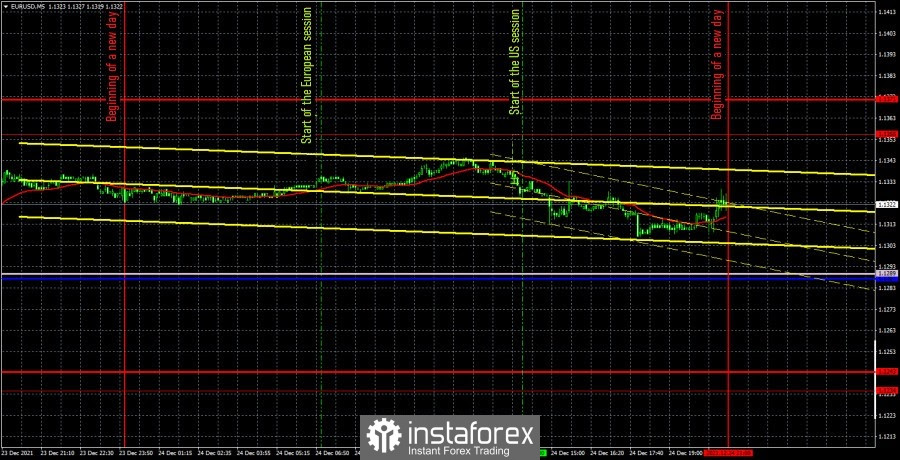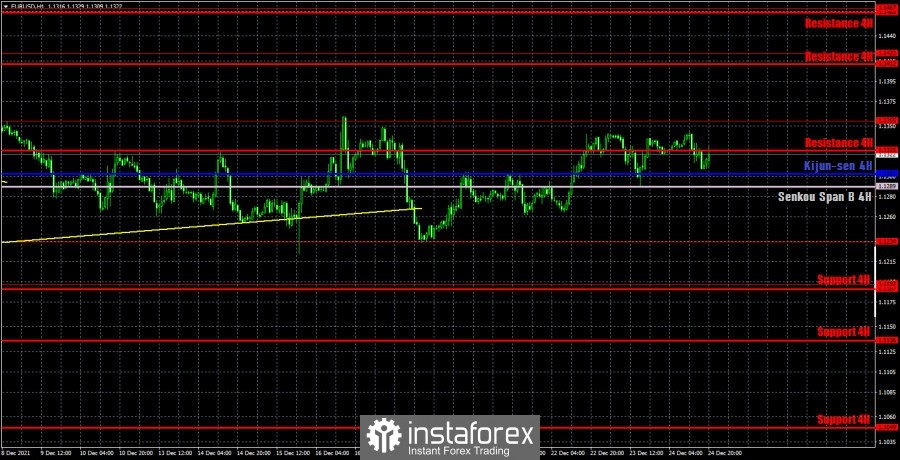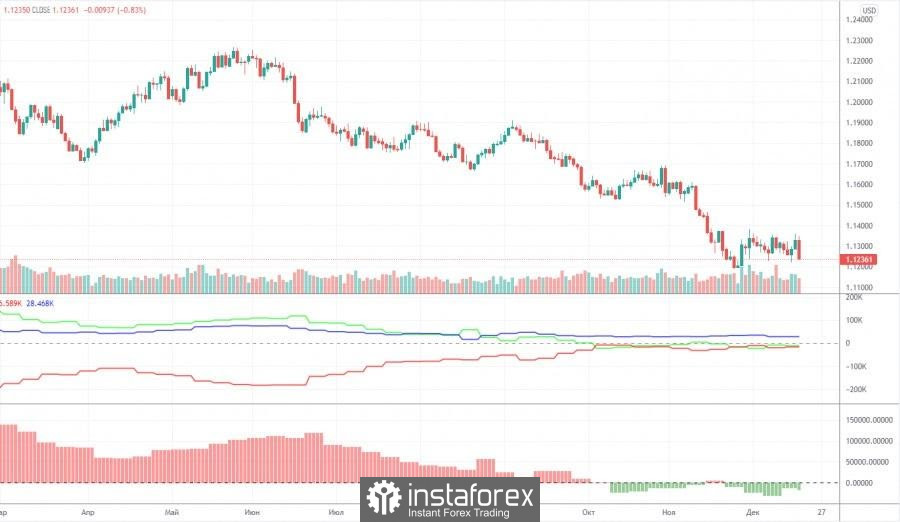EUR/USD 5M

The EUR/USD pair was trading as calmly as possible during the last trading day of the week. Despite the fact that the volatility was not the lowest, the movements were still weak. However, hardly any of the market participants were surprised by this movement of the pair. We have said more than once that Friday was, in fact, a half-day off. An empty calendar of macroeconomic events made it impossible to predict a strong movement. Most of the traders left the market in advance, and the market itself closed three hours earlier than usual on Friday. Therefore, absolutely nothing remarkable happened on the 5-minute timeframe and not a single trading signal was generated. During the last week of 2021, you can still trade from extreme levels, but the Ichimoku indicator lines are weak, so the signals around them should be as accurate and clear as possible so that they can be worked out.
EUR/USD 1H

On the hourly timeframe, you can clearly see that the pair continues to trade exclusively between the levels of 1.1234 and 1.1355. Thus, the technical picture has not changed for about a month. At the moment, the pair is near the upper border of this channel, so there is a possibility of a rebound from the level of 1.1355 and a downward movement to the lower border of 1.1234. No more conclusions drawn. We highlight the following levels for trading on Monday - 1.1192, 1.1234, 1.1355, 1.1422, as well as the Senkou Span B (1.1289) and Kijun-sen (1.1302) lines. The Ichimoku indicator lines can change their position during the day, which should be taken into account when looking for trading signals. Signals can be "rebounds" and "breakthroughs" of these levels and lines. Do not forget about placing a Stop Loss order at breakeven if the price moves 15 points in the right direction. This will protect you against possible losses if the signal turns out to be false. You should also take into account the fact that the pair remains flat, so the lines of the Ichimoku indicator are weak. No important event or macroeconomic report in the European Union and the United States on December 27, so we do not expect strong movements today.
We recommend you to familiarize yourself:
Overview of the EUR/USD pair. December 27. The "Coronavirus Holidays" have begun.
Overview of the GBP/USD pair. December 27. UK: Disease continues to rise.
Forecast and trading signals for GBP/USD for December 27. Detailed analysis of the movement of the pair and trade deals.
Analysis of the COT report

The mood of non-commercial traders has become... a little more bearish during the last reporting week (December 7-13). The "non-commercial" group of traders now has more short positions than long ones, but this advantage is minimal. The difference is only 18,000 contracts, which is not so much. During the reporting week, professional traders closed 7,200 buy contracts (longs) and 2,800 sell contracts (shorts). Thus, the net position of professional players decreased by 4,000. However, the main thing to note is that the green and red lines of the first indicator (indicating the change in the net positions of the non-commercial and commercial groups) have been near the zero level for a long time, as well as in close proximity to each other. That is, in the last few months, when the European currency continued to fall against the dollar, the major players no longer increased their shorts. Thus, the question arises, why did the euro fall at all if market participants did not sell it? Perhaps global factors, such as changes in the balance between the EU and US money supply, are interfering in the exchange rate formation process again. But according to the Commitment of Traders (COT) reports, we can only conclude that the bearish mood is minimal and has not intensified in recent months. Nevertheless, taking into account the fundamental background, the euro may continue to fall. And the technical picture does not yet give any reason to assume the completion of the fall of the euro currency. The mood of the major players remains bearish, but at the same time the bulls do not seek to change anything.
Explanations for the chart:
Support and Resistance Levels are the levels that serve as targets when buying or selling the pair. You can place Take Profit near these levels.
Kijun-sen and Senkou Span B lines are lines of the Ichimoku indicator transferred to the hourly timeframe from the 4-hour one.
Support and resistance areas are areas from which the price has repeatedly rebounded off.
Yellow lines are trend lines, trend channels and any other technical patterns.
Indicator 1 on the COT charts is the size of the net position of each category of traders.
Indicator 2 on the COT charts is the size of the net position for the non-commercial group.
 English
English 
 Русский
Русский Bahasa Indonesia
Bahasa Indonesia Bahasa Malay
Bahasa Malay ไทย
ไทย Español
Español Deutsch
Deutsch Български
Български Français
Français Tiếng Việt
Tiếng Việt 中文
中文 বাংলা
বাংলা हिन्दी
हिन्दी Čeština
Čeština Українська
Українська Română
Română

